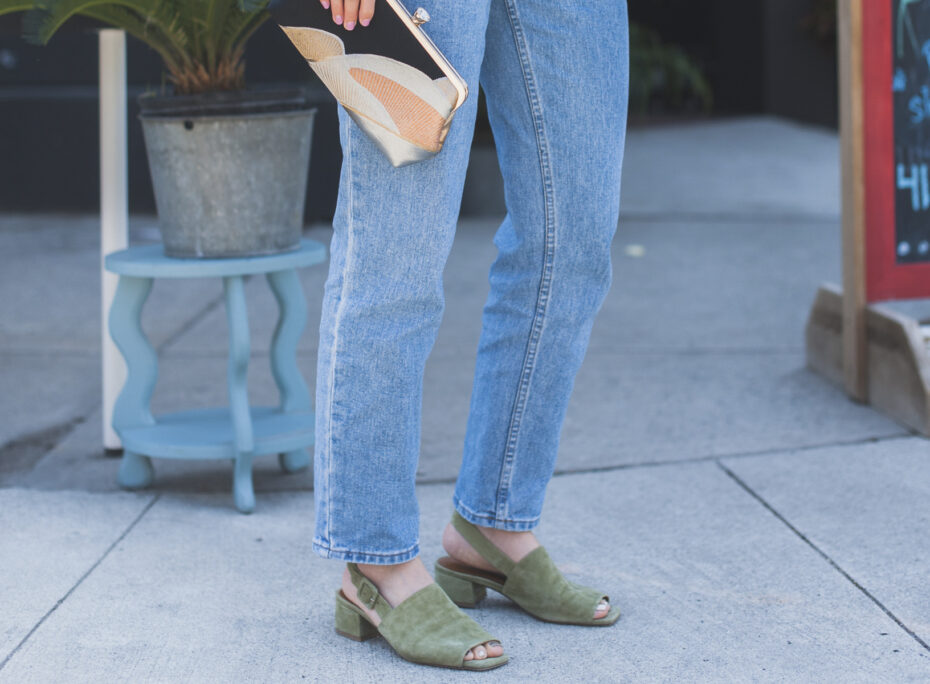Why I Wear No Logos
From grade school to high school, I managed to evade the omnipresent desire for branded clothes: Tommy, Calvin, Abercrombie, Nike. Those Gap hoodies. Those velour tracksuits with JUICY splashed across the butt. Those tight-fitting polo shirts with little green alligators. Once in middle school, a classmate's pride in her new baby tee emblazoned with a massive CK Jeans logo made me cringe; I was embarrassed for all my peers who placed alarming importance on turning themselves into human billboards.
But I wasn't any better in my late teens and early twenties when I lusted after designer purses. I blame women's magazines, Kate Moss, and Sex in the City. Splurging on It bags to keep up with the It girls was the way to go when fast fashion had you covered with the rest of the outfit. While I still found monogrammed purses, like those LV Speedy bags, to be terribly cheesy, I really wanted a classic black quilted Chanel. Owning one would be my gateway to womanhood. Unclasping those gold interlocking CCs would open the doors. Of course, as a poor high school student, and an even poorer university student, I didn't have the cash for a real one. So I got a fake. Or rather asked my boyfriend at the time to buy the specific fake I wanted for my birthday.
While it was an exact duplicate, I hated that bag—and myself for owning it. For years I stuck it in its fake box with the fake verification cards until one day, I threw it in the trash.

Fast forward to present day, still without a real Chanel purse but somehow a real woman. My aversion to logos has slowly snowballed over the years, at first a subconscious decision, and now something I fully stand behind. No matter how much I admire a designer, I won't wear the brand's logo.
So what's the big deal? I can admit that some logos can be aesthetically pleasing, a design statement in its own right. They announce to the world who or what you stand behind.
Well, that's exactly what I want to avoid. Stylist Rachel Zoe said, "Style is a way to say who you are without having to speak." Wearing a logo is speaking, and in a very lazy way, because it is the tacky shortcut to being the person you want the world to see. Let's face it: most designer logos worn are announcing "I'm rich AF," or, depending on the nuanced message behind each brand, "I'm classy and rich AF," "I'm hip and rich AF," "I'm edgy and rich AF." In reality, it's more like "Okay, I'm broke AF, but I want everyone to know I can at least afford this overpriced T-shirt."
If you mentally remove the logo from any item you covet, would it still have the same cachet? Would that Chanel bag still be worth $4000? How are you liking that plain white tee you just paid $300 for? Or that simple brown bag that's not even leather but plastic?
How much is a logo worth? For many companies, they know it's ridiculously more than producing the product itself. The book Deluxe: How Luxury Lost Its Luster uncovers the shady industry of corporations buying designer brands and pumping out lower price point items under their branding to the masses while cutting corners in production.
"Products are made in the factory, but brands are made in the mind"
When logos and branding become the products' focus, everyone loses except for the corporation. Production is moved to cheap factories in third-world countries where workers are basically modern-day slaves. Quality gets shoddier the more the company focuses on financial growth. When I read No Logo: Taking Aim at the Brand Bullies by Canadian author Naomi Klein earlier this year, I wanted to highlight every other line. Even though it was published in 1999, and so massive a hit the NYT called it a "movement bible," the messages of the book are, sadly, more relevant than ever.

In the book, how Tommy Hilfiger made millions in the late '90s perfectly summarizes streetwear brands' formula. They did it by "selling white youth on their fetishization of black style, and black youth on their fetishization of white wealth." They saw "a peculiar cachet in the inner cities, where the hip-hop philosophy of "living large" saw poor and working-class kids acquiring status in the ghetto by adopting the gear and accoutrement of prohibitively costly leisure activities, such as skiing, golfing, even boating.... urban fantasy."
"Once Tommy was firmly established as a ghetto thing, the real selling could begin—not just to the comparatively small market of poor inner-city youth but to the much larger market of middle-class white and Asian kids who mimic black style in everything from lingo to sports to music. Company sales reached $847 million in 1998—up from a paltry $53 million in 1991..." (pg 76)
Nike didn't care when middle-class white people protested their overseas sweatshop practices, but when black and Latino kids from the Bronx were planning a revolt, they had to do damage control. "If a backlash took root in the inner cities, it could sink the brand at the mall." As a social worker in the Bronx said, "Our kids are exactly who Nike depends upon to set the trends for them so that the rest of the country buys their sneakers." (pg 373)
"...Kids incorporate the brands into gang-wear uniforms; some want the gear so badly they are willing to sell drugs, steal, mug, even kill for it." (pg 370)
Some of the statements in the book made me recall my own memories of attending an inner-city school, the kind Nike and other brands so depended on to inject credibility in their streetwear. Nike must've donated some sneakers to my school once because a bunch of us got free pairs for being on the girls' softball team. A classmate was so jealous that I got sneakers and she didn't that she snatched my shoebox and tried to run away with them. I chased her down and got them back, not because I cared about the shoes, but I didn't like anyone stealing from me.
"I can feel that kid's inner need—this desire to own these things and have the feelings that go with them—but it hurts me that this is the way things are," a Newark shoe store owner said of selling street fashion to kids on welfare. (pg 370)
Does it have to be this way?
I was excited when normcore became big in fashion a few years ago because consumers were subverting the latest trends and "hot" brands in favour of bland basics. To me, it simply meant taking pride in personal style. Kate Middleton was normcore. The cast of Seinfeld was normcore. Steve Jobs was normcore.
Of course, the brands, ever the cool hunters, came chasing. Gap and American Apparel claimed to be normcore-ing since day one, and fashion magazine put out style guides for the "normcore look," which often included plastic Adidas slide sandals for some reason.

Wherever the youth go, the cool hunters employed by middle-aged men will follow. You can be sure I won't be buying into any brands cashing in on modern movements. No "Feminist" tees, no "Save the Bees" totes, no charity-logoed shirts.
Part of this is due to my stubbornness of not wanting to be categorized in any way. Am I rich or am I poor? Am I a hip kid or old with grandma aesthetics? Am I a fashionista or an intellectual? If no one can tell, all the better; people have to get to know me to really know me. When I buy a piece of clothing, I'm already forced to choose how to present myself to the world, and I refuse to bear any more signage. Even if it's for social good and empowerment; I'm a person, not a cause.
These days, I wear a lot of bland basics mixed in with eclectic vintage and secondhand finds, and mid-priced, ethically-made designer. I like comfortable outfits that can take me from hole-in-the-wall bars to upscale restaurants. I like that people often can't tell if something I'm wearing is from a cool indie designer or a thrift shop. I like choosing pieces based on quality and design instead of letting a brand's "meaning" dictate my style. I don't put my faith and identity in symbols. I don't let my clothes wear me. I don't want or need anyone, especially a corporation, to speak for me.
Adrian
wrote:What a fantastic article. So glad I read this. I dislike logos as I’m paying to advertise them.
I wonder if Louis Vuitton realise their handbags are ‘de rigeur’ for practically every Thai escort in the UK….
Identity of people is not formed by the words and images on their clothes – and it’s really sad that for some people, their identity is subverted this way.
Annie Zhu
author wrote:Nicely put. Thanks for sharing!
Su
wrote:Well said. All my life I have refused to walk around advertising brands….they should pay me for the adverts!
Annie Zhu
author wrote:Ha, totally!